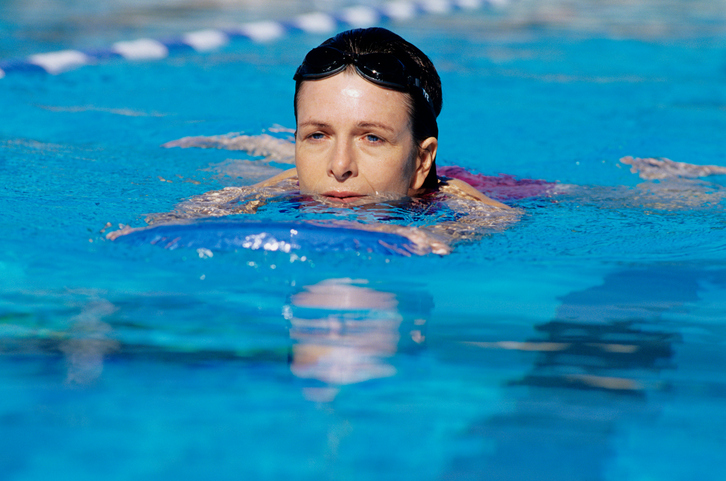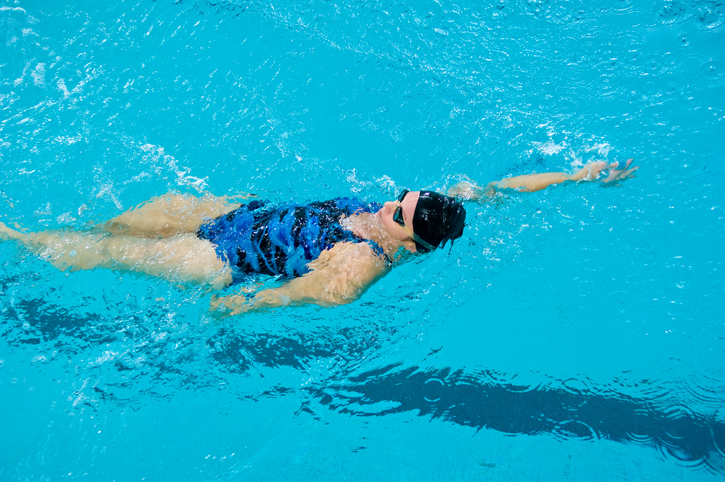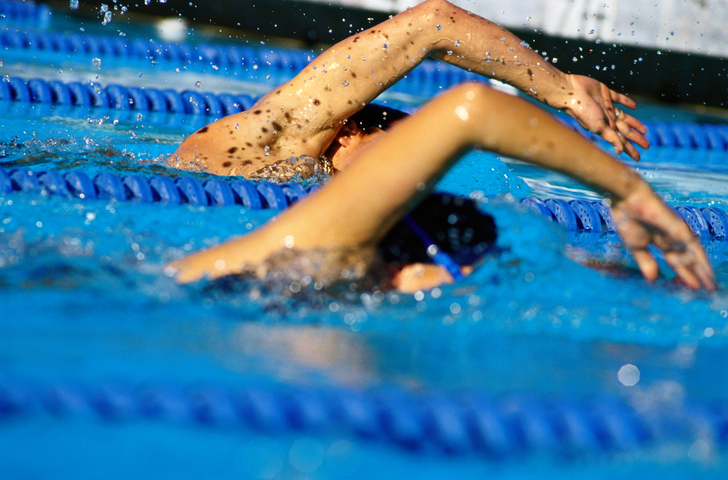Swimming to a Healthy Lifestyle
22 August 2016
Posted in

In Oklahoma, the summer heat lasts well into September, with pools staying busy until Labor Day. If you’re normally more of a dog-paddler, take the plunge during the remaining days of summer and learn the basics of swimming.
 As one of the most basic swimming strokes, the breaststroke is often the first movement taught to novice swimmers. At a beginner level, you can keep your head above water while completing the stroke, which allows you to maintain good visibility and avoid breathing issues.
To complete the breaststroke, keep your body in a flat position throughout the entire movement. You will hold your hands extended above your head and your legs extended in a straight line behind. This is the core position of the breaststroke, called the glide phase, and it is the movement your body should return to in a neutral position.
The actual movement of the breaststroke has three key steps.
As one of the most basic swimming strokes, the breaststroke is often the first movement taught to novice swimmers. At a beginner level, you can keep your head above water while completing the stroke, which allows you to maintain good visibility and avoid breathing issues.
To complete the breaststroke, keep your body in a flat position throughout the entire movement. You will hold your hands extended above your head and your legs extended in a straight line behind. This is the core position of the breaststroke, called the glide phase, and it is the movement your body should return to in a neutral position.
The actual movement of the breaststroke has three key steps.
 The backstroke is another basic swimming stroke. While lying face-up, your legs should alternatively kick up and down, while your arms move in an alternate windmill-like motion. For proper form, your straight arm recovers above the water in a circular motion from the hip, all the way back. Both arms should stay fully extended throughout the stroke.
With the backstroke, you don’t have to worry about breathing issues as long as you are able to remain balanced. This stroke especially works your core muscles and is good for long-distance swimming. The backstroke is often used as a remedy for back problems, as it strengthens your back muscles and core strength.
With a limited line of sight in this position, awareness of your surroundings is key, so rookie swimmers may want to practice the backstroke in a pool with ample space.
The backstroke is another basic swimming stroke. While lying face-up, your legs should alternatively kick up and down, while your arms move in an alternate windmill-like motion. For proper form, your straight arm recovers above the water in a circular motion from the hip, all the way back. Both arms should stay fully extended throughout the stroke.
With the backstroke, you don’t have to worry about breathing issues as long as you are able to remain balanced. This stroke especially works your core muscles and is good for long-distance swimming. The backstroke is often used as a remedy for back problems, as it strengthens your back muscles and core strength.
With a limited line of sight in this position, awareness of your surroundings is key, so rookie swimmers may want to practice the backstroke in a pool with ample space.
 Lastly, the freestyle stroke is the fastest and perhaps most common swimming stroke, especially in competitions. You begin flat on your stomach and execute a flutter kick with your feet. Meanwhile, your arms will execute an alternate motion where they recover from the hip to the front above water, and then catch and pull back to the hip under your body in the water.
This stroke is quick, but it is also more challenging because your face is submerged. With freestyle, you have to learn how to rotate your head to the side between strokes in order to breathe. This takes practice, but once mastered, you can enjoy one of the fastest swimming strokes.
Make a splash in these last few weeks of summer with a new fitness routine and learn how to master a few of these swimming strokes. But don’t let the cooler weather slow you down – there are plenty of public indoor pools across Oklahoma where you can put your fitness to the test and swim your way to health and wellness. Livestrong.com offers excellent videos to help you learn how to swim the breaststroke, backstroke and freestyle stroke.
Lastly, the freestyle stroke is the fastest and perhaps most common swimming stroke, especially in competitions. You begin flat on your stomach and execute a flutter kick with your feet. Meanwhile, your arms will execute an alternate motion where they recover from the hip to the front above water, and then catch and pull back to the hip under your body in the water.
This stroke is quick, but it is also more challenging because your face is submerged. With freestyle, you have to learn how to rotate your head to the side between strokes in order to breathe. This takes practice, but once mastered, you can enjoy one of the fastest swimming strokes.
Make a splash in these last few weeks of summer with a new fitness routine and learn how to master a few of these swimming strokes. But don’t let the cooler weather slow you down – there are plenty of public indoor pools across Oklahoma where you can put your fitness to the test and swim your way to health and wellness. Livestrong.com offers excellent videos to help you learn how to swim the breaststroke, backstroke and freestyle stroke.
Health Benefits of Swimming
Swimming – even non-competitive swimming – is a great activity because it keeps your heart rate pumping while being easier on your body than high-impact activities like running. Swimming builds endurance, muscle strength and cardiovascular fitness, and can help you maintain a healthy weight while also building a strong heart and lungs. Besides the physical benefits, swimming can be a relaxing form of exercise and help alleviate stress. It is an ideal sport as you are recovering from an injury or just beginning an active lifestyle, because it won’t put stress on your joints and body. If you’re ready to dive in, here are three basic strokes everyone should learn for their next pool workout.Different Swimming Strokes
If you’ve never taken a beginner’s swimming class before, don’t worry: it’s never too late to begin. These strokes are great for beginners to practice.The Breaststroke
 As one of the most basic swimming strokes, the breaststroke is often the first movement taught to novice swimmers. At a beginner level, you can keep your head above water while completing the stroke, which allows you to maintain good visibility and avoid breathing issues.
To complete the breaststroke, keep your body in a flat position throughout the entire movement. You will hold your hands extended above your head and your legs extended in a straight line behind. This is the core position of the breaststroke, called the glide phase, and it is the movement your body should return to in a neutral position.
The actual movement of the breaststroke has three key steps.
As one of the most basic swimming strokes, the breaststroke is often the first movement taught to novice swimmers. At a beginner level, you can keep your head above water while completing the stroke, which allows you to maintain good visibility and avoid breathing issues.
To complete the breaststroke, keep your body in a flat position throughout the entire movement. You will hold your hands extended above your head and your legs extended in a straight line behind. This is the core position of the breaststroke, called the glide phase, and it is the movement your body should return to in a neutral position.
The actual movement of the breaststroke has three key steps.
- Begin in a glide, then move to an “out-sweep.” In this movement, you turn your palms slightly outwards and your arms slide sideways until they are outside of the shoulders.
- Next, there is the catch. In this movement, the orientation of your arms should move your forearms and palms until they are facing backward. You should flex your arms at the elbows until your forearms are vertical and facing backward and your palms are in line with your forearms.
- Lastly, you will do an “in-sweep.” In this movement, the hand pulls in towards the chest, meets below the chest, and then propels the movement forward.
The Backstroke
 The backstroke is another basic swimming stroke. While lying face-up, your legs should alternatively kick up and down, while your arms move in an alternate windmill-like motion. For proper form, your straight arm recovers above the water in a circular motion from the hip, all the way back. Both arms should stay fully extended throughout the stroke.
With the backstroke, you don’t have to worry about breathing issues as long as you are able to remain balanced. This stroke especially works your core muscles and is good for long-distance swimming. The backstroke is often used as a remedy for back problems, as it strengthens your back muscles and core strength.
With a limited line of sight in this position, awareness of your surroundings is key, so rookie swimmers may want to practice the backstroke in a pool with ample space.
The backstroke is another basic swimming stroke. While lying face-up, your legs should alternatively kick up and down, while your arms move in an alternate windmill-like motion. For proper form, your straight arm recovers above the water in a circular motion from the hip, all the way back. Both arms should stay fully extended throughout the stroke.
With the backstroke, you don’t have to worry about breathing issues as long as you are able to remain balanced. This stroke especially works your core muscles and is good for long-distance swimming. The backstroke is often used as a remedy for back problems, as it strengthens your back muscles and core strength.
With a limited line of sight in this position, awareness of your surroundings is key, so rookie swimmers may want to practice the backstroke in a pool with ample space.
The Freestyle Stroke
 Lastly, the freestyle stroke is the fastest and perhaps most common swimming stroke, especially in competitions. You begin flat on your stomach and execute a flutter kick with your feet. Meanwhile, your arms will execute an alternate motion where they recover from the hip to the front above water, and then catch and pull back to the hip under your body in the water.
This stroke is quick, but it is also more challenging because your face is submerged. With freestyle, you have to learn how to rotate your head to the side between strokes in order to breathe. This takes practice, but once mastered, you can enjoy one of the fastest swimming strokes.
Make a splash in these last few weeks of summer with a new fitness routine and learn how to master a few of these swimming strokes. But don’t let the cooler weather slow you down – there are plenty of public indoor pools across Oklahoma where you can put your fitness to the test and swim your way to health and wellness. Livestrong.com offers excellent videos to help you learn how to swim the breaststroke, backstroke and freestyle stroke.
Lastly, the freestyle stroke is the fastest and perhaps most common swimming stroke, especially in competitions. You begin flat on your stomach and execute a flutter kick with your feet. Meanwhile, your arms will execute an alternate motion where they recover from the hip to the front above water, and then catch and pull back to the hip under your body in the water.
This stroke is quick, but it is also more challenging because your face is submerged. With freestyle, you have to learn how to rotate your head to the side between strokes in order to breathe. This takes practice, but once mastered, you can enjoy one of the fastest swimming strokes.
Make a splash in these last few weeks of summer with a new fitness routine and learn how to master a few of these swimming strokes. But don’t let the cooler weather slow you down – there are plenty of public indoor pools across Oklahoma where you can put your fitness to the test and swim your way to health and wellness. Livestrong.com offers excellent videos to help you learn how to swim the breaststroke, backstroke and freestyle stroke.
